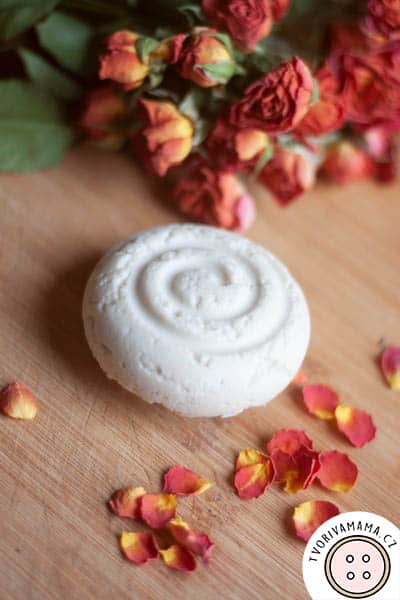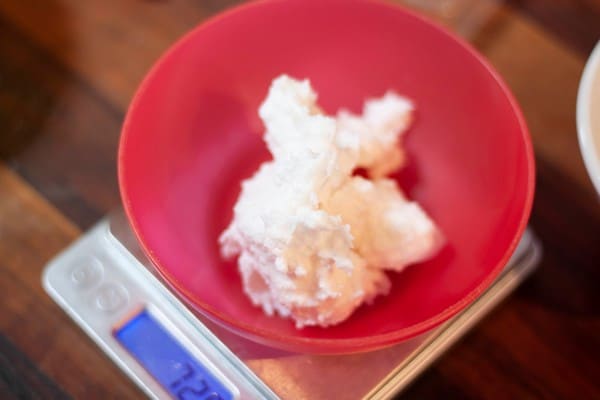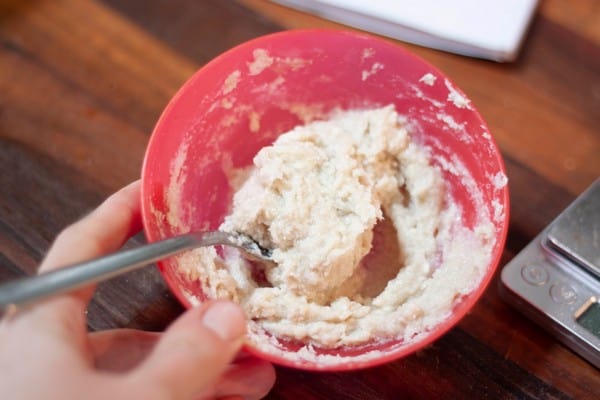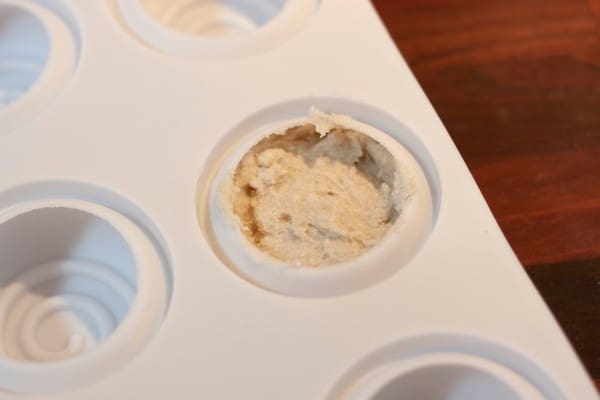Rose shampoo bar is ideal for travels as well as use at home. It has a beautiful fragrance and leaves your hair smooth and shiny.
![]()
(This post may contain affiliate links that help me support this blog and create more tutorials for you.)
“A rose by any other name would smell as sweet.”
— William Shakespeare: Romeo a Julie
I really like homemade rose cosmetics, which is probably not difficult to guess if you follow my blog. I absolutely love my Luxurious Rose Lip Balm, I use the Make-up Remover with Rose Water, the Rose Clay Face Mask and the Homemade Rose and Lemon Balm Shampoo. I use the rose fragrance and oil also in some of my soaps which I’m going to show you another time.
Table of Contents
Shampoo(k) bar, liquid shampoo or solid shampoo?
 Shampook is a shampoo bar but quite different from the shampoo bar that looks like soap and goes through saponification. Shampook is more like the typical liquid shampoo that has great lather and generally leaves you with the feeling of freshly washed hair (unlike the soap shampoo bars that take some time getting used to). It’s made from surfactants which are responsible for the lather that helps clean the hair. I like combining the surfactants SLSA, SCI and Perlastan as the combination works better than using just one type.
Shampook is a shampoo bar but quite different from the shampoo bar that looks like soap and goes through saponification. Shampook is more like the typical liquid shampoo that has great lather and generally leaves you with the feeling of freshly washed hair (unlike the soap shampoo bars that take some time getting used to). It’s made from surfactants which are responsible for the lather that helps clean the hair. I like combining the surfactants SLSA, SCI and Perlastan as the combination works better than using just one type.
Which shampoo shall I choose?
Great question. Soap shampoo bars tend to be the most problematic as they can make your hair heavy and lank, especially in the first weeks and some hair just never gets used to it. On the other hand, they can be also very beneficial and help with extremely fragile hair. Among soap-based shampoos I prefer liquid ones like the aforementioned Rose and Lemon Balm Shampoo. I was figuring the recipe out for a while until I found the ideal oil ratio so that the shampoo doesn’t make my hair lank but leaves it fresh and shiny.
Anyway, you just have to try for yourself and see what kind of shampoo is ideal for your hair.
Why is Shampoo(k) bar so great
As I mentioned, the shampoo bar doesn’t leave your hair with weird texture. Besides that, it’s ideal for travels, you just put it in a box and you don’t need to worry for the shampoo spilling.
With correct ingredient ratio and enough curing time the shampoo(k) will last long. Whether you buy it or make it at home, it’s not a cheap shampoo. However, if it lasts, the price of every hair washing is more than reasonable. My 90g shampoo lasts for approximately 2 months when I wash my hair two to three times a week.
Last but not least, let’s not forget that making your shampoo at home means you know exactly what’s in it.
Pricewise…
Shampoo bars of 90 grams can cost approximately between 10 and 18 Euros/10.8 to 19.5 USD. It’s no rip-off because the ingredients aren’t cheap, especially high quality oils and surfactants.
To have an idea about the price of the homemade shampook I count the ingredients. I don’t really include the energies used but it’s just a few minutes so I just sum a little to the ingredient price. This particular shampoo costs about 4,6 EUR/5 USD to make. Of course, what greatly impacts the price is the place to buy the ingredients. Also, you can skip things like liquid silk, you can replace essential oils with cheaper fragrances…but you will see it in the quality of the resulting product.
Supplies
This is an amount of ingredients for two shampoo(k) bars of 90 grams/3.17 oz. If you want just one, use half of the amounts given.
Phase A
- 70 g/2.5 oz of SLSA surfactant
- 40 g/1.4 oz of SCI surfactant
- 12 g/0.4 oz of Perlastan surfactant
- 15 g/0.5 oz of rose hydrolate
- 8 g/0.3 oz of liquid silk
Phase B
- 8 g/0.3 oz of palm kernel oil
- 4 g/0,14 oz of mango butter
- 2 g/0.07 oz of avocado oil
Phase C
- 6 g/0.2 oz of diatomite (kieselgur)
- 6 g/0.2 oz of panthenol
- 4 g/0.14 oz of sodium lactate
- 20 drops of rose essential oil or pau-rosa essential oil
Tools
- shampoo bar/soap mold – plain round molds like this one are ideal but for this shampoo bar you can use a mold with ornaments like this one
- pans for the water bath
- one beaker for each phase
- wooden or plastic stirring spoons/sticks
- silicone spatula
- digital thermometer – use one that you can immerse in the mixture like this one
- digital scales – I have this one
I have already talked about the sufactants. I add liquid silk to all my shampoo bars because the silk proteins and amino acids are what makes the hair soft and shiny. Rose hydrolate or rose water is known for its beneficial effects on the skin and hair – it cleans and hydrates. I combined the oils in a way that works for this shampoo and doesn’t make it too soft. All of them are good for the hair and skin. The diatomite (or diatomaceous earth) is an important source of the minerals, panthenol regenerates and hydrates and sodium lactate helps make the bar more solid. I use the essential oils here for their fragrance but all EOs have their health benefits. Pau-rosa has actually nothing to do with our usual rose but I find that its fragrance compliments the rose water fragrance.

It’s worth investing into quality tools.
How to make Rose Shampoo(k) Bar

Melt phase A in the water bath and check until the temperature is 65-70°C/149-158°F. Melt also the oils and butters in phase B and heat to the same temperature. Incorporate phase B into phase A.
Take it out of the water bath and add the diatomite and sodium lactate. When the mixture is at 35-37°C/95-98.6°F, add panthenol and essential oil.

Fill the mold with the mixture and let it sit until it solidifies (it takes a few hours but I usually wait a whole day).

Take it out carefully and let it cure for 2 weeks in a dry ventilated place. You can use it immediately but if you let it cure, the water evaporates and the bar will last longer.
How to use the Shampoo(k) Bar
Wet it in your hands and run with it over wet hair several times. It will lather almost instantly and you’ll need only a little of the shampoo to wash even long hair. Let it work for several minutes and rinse your hair.